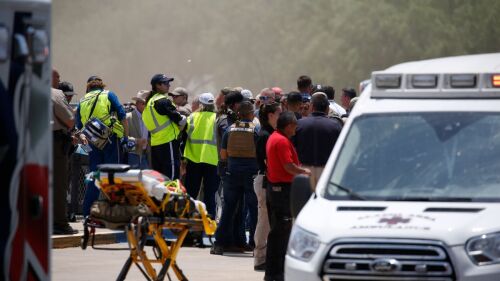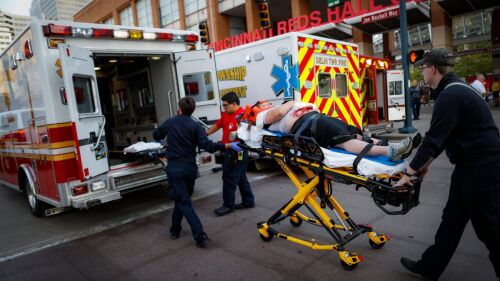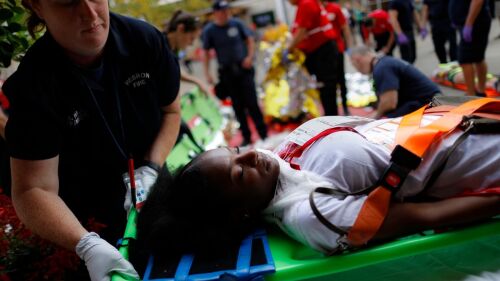By Sally Krutzig
The Idaho Statesman
BOISE, Idaho — Forms filled out by members of the Boise Fire Department provide new details about what first responders found and observed at the site of a deadly building collapse Jan. 31 near the Boise Airport.
These initial records, obtained by the Idaho Statesman through a public records request, reveal comments about the collapse’s possible origin and the ensuing rescue operations, which included saving three people who were stuck in aerial lifts crushed by the falling steel. The “AAR (After Action Review) Lessons Learned” documents will be finalized at a later date.
The building under construction was to become a new hangar for the private Jackson Jet Center adjacent to the airport. The Boise Police and Fire departments received calls of the collapsed structure near Rickenbacker and Luke streets at approximately 5 p.m. on Jan. 31, the Statesman previously reported.
Three people died at the scene and five others were reported in critical condition the night of the collapse. Four more were listed as injured. No updates have been provided on the injured.
PREVIOUSLY:
- ‘It was a very chaotic scene': 3 dead, 9 injured in collapse at Idaho airport
- Contractor in fatal Idaho collapse had history of safety violations
In his review, Boise Fire Department Training and Safety Capt. Steve Madigan wrote that “it appeared that the structure somehow failed at the ridge line and caused all the columns to pull inward.” Initial reports indicated 16 people were at the scene when the building went down, and police and fire crews helped wounded victims who were able to walk leave the area, according to Madigan.
The building’s columns “were leaning at 45 degrees (approx.) and the bolts securing them to the ground had either sheared off or tore the bottom flange of the steel as they fell,” Madigan wrote.
A ridge line of a building refers to the “top of a roof at its highest elevation,” according to Law Insider.
Before the collapse, construction crews had erected the “main steel” and were in the process of installing the purlins — horizontal roof beams — and attaching them to the main structural steel, according to Madigan.
“Purlins were attached to the majority of the roof, with the exception of two bays (assuming allowance for crane operations),” Madigan wrote. “Some C‐channel supports were attached along the exterior of the walls, as well.”
No siding, roof decking or mechanical units were attached to the building at the time of its collapse, according to Madigan, who added that a large crane was near the middle of the structure and that several man lifts, also known as aerial lifts, were caught in the collapse.
Inland Crane, a Boise-based crane servicer, was hired to help construct the hangar, according to a news release from Vice President Jeremy Haener previously reported by the Statesman. Four of the company’s cranes were used at the site to start with, and with the work largely completed by the day of the collapse, only one crane remained, he said.
“At the time of the accident, the final crane was in service to place an end truss,” Haener wrote. “When the building collapsed due to an unknown structural failure, the crane boom — the hydraulic arm of the equipment — snapped on impact.”
Rescuers had to help victims stuck in lifts
The reports gave a glimpse of rescue operations carried out by the Boise Fire Department.
Three people were stuck in the lifts and had to be rescued, firefighter Jeff Sawmiller wrote in his report. Sawmiller said he helped one victim by lowering him in a stretcher.
Sawmiller also wrote that when he arrived, he learned that there were three patients whose condition was at a “black” level and three at a “red” level near the center of the collapse.
During mass casualty incidents, emergency responders use a color-coded triage system, with “black” meaning they are not breathing or have fatal injuries and should not be moved, according to the National Institutes of Health. “Red” means people have severe injuries with a high potential for survival, so priority should be given to moving them to collection points.
The three people found dead were “left in place until the coroner arrived and directed their removal,” Madigan wrote. Those victims — Craig Durrant, 59, of Boise; Mariano Coc Och, 24, of Nampa; and Mario Sontay Tzi, 32, of Nampa — died at the scene from traumatic blunt force injuries, according to the Ada County Coroner’s Office.
The AAR reports also described challenges faced by emergency responders.
“I quickly recognized that the way the incident was set up was not how we as a BC (battalion chief) group had preplanned running a large-scale incident at the airport,” Boise Fire Department Operations Chief Aaron Hummel wrote in his report. “However, the incident was so far along and seemed to be running effectively.”
Sawmiller indicated in his report that he had to tell at least 10 police officers to stop standing in the collapse zone.
Other challenges listed in the reports were difficulties communicating with non-English-speaking victims, having agencies operating on different radio frequencies and keeping bystanders out of the site.
©2024 The Idaho Statesman.
Visit idahostatesman.com.
Distributed by Tribune Content Agency, LLC.







